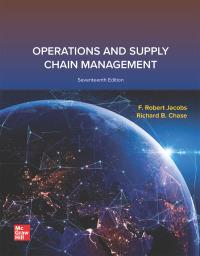In each of the following, name the term defined or answer the question. Answers are listed at
Question:
In each of the following, name the term defined or answer the question. Answers are listed at the bottom.
1. The model most appropriate for making a one-time purchase of an item.
2. The model most appropriate when inventory is replenished only in fixed intervals of time—for example, on the first Monday of each month.
3. The model most appropriate when a fixed amount must be purchased each time an order is placed.
4. Based on an EOQ-type ordering criterion, what cost must be taken to zero if the desire is to have an order quantity of a single unit?
5. Term used to describe demand that can be accurately calculated to meet the need of a production schedule, for example.
6. Term used to describe demand that is uncertain and needs to be forecast.
7. We are ordering T-shirts for the spring party and are selling them for twice what we paid for them. We expect to sell 100 shirts and the standard deviation associated with our forecast is 10 shirts. How many shirts should we order?
8. We have an item that we stock in our store that has fairly steady demand. Our supplier insists that we buy 1,200 units at a time. The lead time is very short on the item because the supplier is only a few blocks away and we can pick up another 1,200 units when we run out. How many units do you expect to have in inventory on average?
9. For the item described in question 8, if we expect to sell approximately 15,600 units next year, how many trips will we need to make to the supplier over the year?
10. If we decide to carry 10 units of safety stock for the item described in questions 8 and 9, and we implemented this by going to our supplier when we had 10 units left, how much inventory would you expect to have, on average, now?
11. We are being evaluated based on the percentage of total demand met in a year (not the probability of stocking out as used in the chapter). Consider an item that we are managing using a fixed–order quantity model with safety stock. We decide to double the order quantity but leave the reorder point the same. Would you expect the percent of total demand met next year to go up or down? Why?
12. Consider an item for which we have 120 units currently in inventory (this includes the safety stock). The average demand for the item is 60 units per week. The lead time for the item is exactly 2 weeks and we normally carry 16 units for safety stock. What is the probability of running out of the item if we order right now?
13. If we take advantage of a quantity discount, would you expect your average inventory to go up or down? Assume that the probability of stocking out criterion stays the same.
14. This is an inventory auditing technique where inventory levels are checked more frequently than one time a year.
Step by Step Answer:

Operations And Supply Chain Management
ISBN: 9781265071271
17th Edition
Authors: F. Robert Jacobs, Richard Chase





